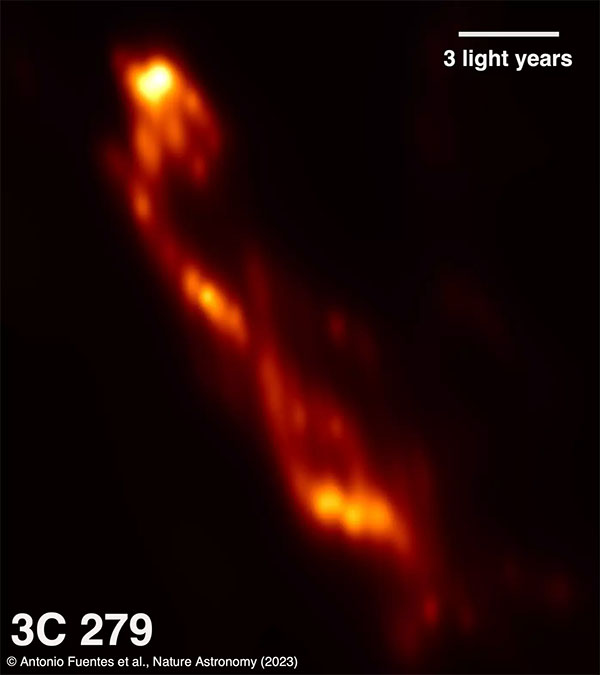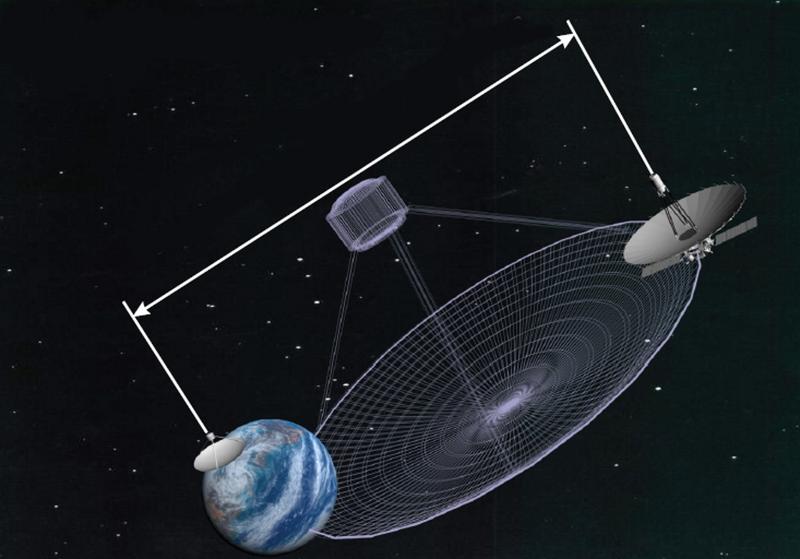| Oct 26, 2023 |
Astronomers capture formation of a powerful cosmic jet
|
|
(Nanowerk News) Using a network of radio telescopes on Earth and in space, astronomers have captured the most detailed view ever of a jet of plasma from a supermassive black hole. The jet travels at nearly the speed of light and shows complex, twisted patterns near its source. These patterns challenge the standard theory that has been used for 40 years to explain how these jets form and change over time.
|
Key Takeaways
|
|
A network of 23 radio telescopes on Earth and one in space have captured an unprecedentedly detailed image of a jet of plasma emitting from a supermassive black hole in the blazar 3C 279.
The observed jet, moving at nearly the speed of light, shows intricate, twisted patterns—termed helical filaments—close to its origin, challenging established theories about how such jets form and evolve.
The Max Planck Institute for Radio Astronomy played a critical role in the study, synthesizing data from various telescopes into a virtual telescope with an effective diameter of roughly 100,000 kilometers.
Researchers suggest that a helical magnetic field might be guiding the jet's plasma, opening new avenues for understanding these cosmic phenomena.
The discovery emphasizes the need for revised theoretical models and highlights the importance of international collaboration in advancing our understanding of the universe.
|
 |
| Entangled filaments in the blazar 3C 279, observed by the RadioAstron program. The image reveals a complex structure within the jet with several parsec-scale filaments forming a helix shape. (Image: NASA/DOE/Fermi LAT Collaboration; VLBA/Jorstad et al.; RadioAstron/Fuentes et al)
|
The Findings
|
|
Blazars are the brightest and most powerful sources of electromagnetic radiation in the cosmos. They are a subclass of active galactic nuclei comprising galaxies with a central supermassive black hole accreting matter from a surrounding disk. About 10% of active galactic nuclei, classified as quasars,,produce relativistic plasma jets. Bazars belong to a small fraction of quasars in which we can see these jets pointing almost directly at the observer.
|
|
Recently, a team of researchers including scientists from the Max Planck Institute for Radio Astronomy (MPIfR) in Bonn, Germany, has imaged the innermost region of the jet in the blazar 3C 279 at an unprecedented angular resolution and detected remarkably regular helical filaments which may require a revision of the theoretical models used until now for explaining the processes by which jets are produced in active galaxies.
|
|
"Thanks to RadioAstron, the space mission for which the orbiting radio telescope reached distances as far away as the Moon, and a network of twenty-three radio telescopes distributed across the Earth, we have obtained the highest-resolution image of the interior of a blazar to date, allowing us to observe the internal structure of the jet in such detail for the first time," says Antonio Fuentes, a researcher at the Institute of Astrophysics of Andalusia (IAA-CSIC) in Granada, Spain, leading the work.
|
|
The new window on the universe opened by the RadioAstron mission has revealed new details in the plasma jet of 3C 279, a blazar with a supermassive black hole at its core. The jet has at least two twisted filaments of plasma extending more than 570 light-years from the centre.
|
|
"This is the first time we have seen such filaments so close to the jet's origin, and they tell us more about how the black hole shapes the plasma. The inner jet was also observed by two other telescopes, the GMVA and the EHT, at much shorter wavelengths (3.5 mm and 1.3 mm), but they were unable to detect the filamentary shapes because they were too faint and too large for this resolution," says Eduardo Ros, a member of the research team and European scheduler of the GMVA. "This shows how different telescopes can reveal different features of the same object," he adds.
|
|
The jets of plasma coming from blazars are not really straight and uniform. They show twists and turns that show how the plasma is affected by the forces around the black hole. The astronomers studying these twists in 3C 279, called helical filaments, found that they were caused by instabilities developing in the jet plasma. In the process, they also realised that the old theory they had used to explain how the jets changed over time no longer worked. Hence, new theoretical models are needed that can explain how such helical filaments form and evolve so close to the jet origin. This is a great challenge, but also a great opportunity to learn more about these amazing cosmic phenomena.
|
|
“One particularly intriguing aspect arising from our results is that they suggest the presence of a helical magnetic field that confines the jet,” says Guang-Yao Zhao, presently affiliated to the MPIfR and member of the scientists team. “Therefore, it could be the magnetic field, which rotates clockwise around the jet in 3C 279, that directs and guides the jet’s plasma moving at a speed of 0.997 times the speed of light.”
|
|
“Similar helical filaments were observed in extragalactic jets before, but on much larger scales where they are believed to result from different parts of the flow moving at different speeds and shearing against each other,” adds Andrei Lobanov, another MPIfR scientist in the researchers team. “With this study, we are entering an entirely novel terrain in which these filaments can be actually connected to the most intricate processes in the immediate vicinity of the black hole producing the jet.”
|
|
The study of the inner jet in 3C 279, now featured in the latest issue of Nature Astronomy ("The filamentary internal structure of the 3C 279 blazar jet"), extends the ongoing strive to understand better the role of magnetic fields in the initial formation of relativistic outflows from active galactic nuclei. It stresses the numerous remaining challenges for the current theoretical modelling of these processes and demonstrates the need for further improvement of radio astronomical instruments and techniques which offer the unique opportunity for imaging distant cosmic objects at a record angular resolution.
|
 |
| RadioAstron VLBI observation provide a virtual telescope of up to eight times the Earth's diameter (350,000 km maximum baseline). (Image: Roscosmos)
|
|
Using a special technique called Very Long Baseline Interferometry (VLBI), a virtual telescope with an effective diameter equal to the maximum separation between the antennas involved in an observation is created by combining and correlating data from different radio observatories. RadioAstron project scientist Yuri Kovalev, now at the MPIfR, emphasises the importance of healthy international collaboration to achieve such results: "Observatories from twelve countries have been synchronised with the space antenna using hydrogen clocks, forming a virtual telescope the size of the distance to the Moon.”
|
|
Anton Zensus, director of the MPIfR and one of the driving forces behind the RadioAstron mission over the last two decades, states: “The experiments with RADIOASTRON that led to images like these for the quasar 3C 279 are exceptional achievements possible through international scientific collaboration of observatories and scientists in many countries. The mission took decades of joint planning before the satellite’s launch. Making the actual images became possible by connecting large telescopes on the ground like Effelsberg and by a careful analysis of the data in our VLBI correlation center in Bonn.”
|


